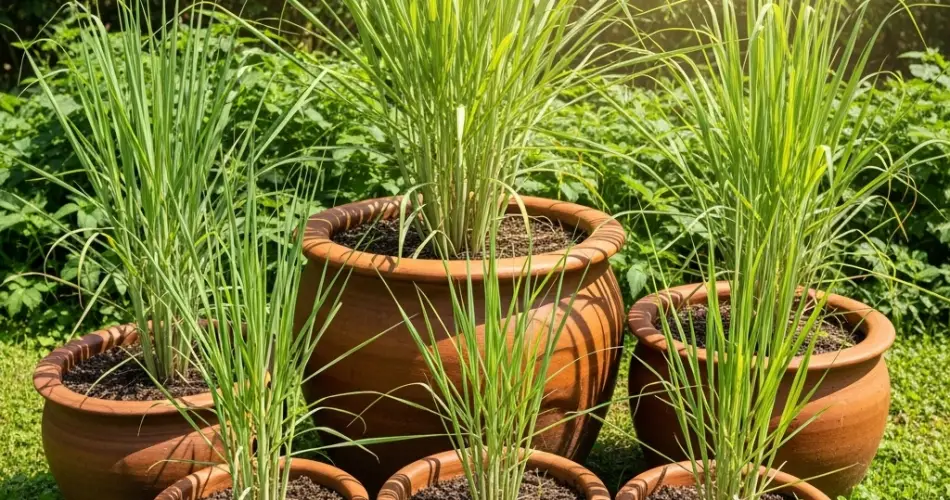Lemongrass is a flavorful and fragrant herb commonly used in Asian cuisine and herbal teas. Its citrusy scent and taste add a refreshing touch to meals, and it also offers a number of health benefits. Even if you don’t have a garden, lemongrass can thrive in containers, making it an ideal plant for small patios, balconies, or sunny kitchen windowsills. With just a few simple techniques, you can successfully grow lemongrass in pots and enjoy a fresh, continuous supply at home.
Choosing the Right Pot
Start with a pot that is at least 12 inches deep and wide. Lemongrass develops a strong root system and needs space to grow. Choose a container with drainage holes to prevent water from accumulating at the bottom, which can lead to root rot. A clay or ceramic pot is ideal because it allows for better air circulation around the roots, but plastic containers will work as long as you monitor moisture levels carefully.
Soil Requirements
Lemongrass prefers well-draining, loamy soil that is rich in organic matter. A good potting mix with added compost or aged manure works well. To improve drainage, you can mix in some sand or perlite. The ideal soil pH for lemongrass is slightly acidic to neutral, around 6.5 to 7.0. Avoid heavy soils that retain too much water, as they can stunt the plant’s growth.
Sunlight and Location
Lemongrass loves sun—at least 6 to 8 hours of direct sunlight each day. Place the pot in the sunniest spot available, such as a south-facing balcony or patio. Indoors, a bright windowsill that gets plenty of light will also suffice. If you’re growing it inside and the natural light is limited, consider using a grow light to supplement.
Planting Lemongrass
You can start lemongrass from seeds, stalks, or transplants. The most common and reliable method is to propagate it from stalks purchased at a grocery store or farmers’ market. Choose firm, healthy stalks with a bit of base intact. Place them in a glass of water and leave them on a sunny windowsill until roots begin to form, usually in one to two weeks.
Once roots are visible, transplant the stalks into your prepared pot, burying the roots and the base of the stalk about an inch below the soil surface. Water well after planting.
Watering and Feeding
Lemongrass enjoys consistently moist soil, especially in warmer weather, but it doesn’t tolerate soggy roots. Water regularly, allowing the top inch of soil to dry out slightly between waterings. During the growing season, feed your plant every 2 to 4 weeks with a balanced liquid fertilizer or a diluted fish emulsion to promote strong growth.
If you notice the tips of the leaves turning brown, it may be a sign that your plant is under-watered or receiving too much sun without enough moisture. Adjust your watering routine as needed.
Pruning and Maintenance
Lemongrass is a fast grower and benefits from occasional pruning. Trim back older outer stalks and any yellowing leaves to encourage new shoots. Regular pruning also helps keep the plant bushy and compact, especially in container settings.
Remove any weeds or debris from the topsoil to prevent pests and diseases. If grown indoors, wipe the pot and check for insect infestations like spider mites or aphids.
Overwintering Lemongrass
In colder climates, lemongrass won’t survive a hard frost. If you live in an area with harsh winters, bring your pots indoors before the first frost. Place them in a sunny window and reduce watering during the dormant period. Alternatively, you can trim the plant down and store the pot in a cool, dry place, watering only occasionally to prevent the roots from drying out.
When spring returns, move the pot back outside gradually to let the plant acclimate to outdoor conditions.
Harvesting Lemongrass
Once the plant is well-established and at least a foot tall, you can begin harvesting. Use a sharp knife to cut the thick outer stalks at the base, leaving the tender inner shoots to continue growing. Regular harvesting encourages new growth and prevents the plant from becoming too woody.
The harvested stalks can be used fresh, frozen, or dried for later use in cooking or herbal remedies.
By following these simple steps, anyone can grow lemongrass successfully in pots, even with limited space. With just a bit of sun, water, and care, you’ll have a fragrant and useful herb right at your fingertips year-round.



